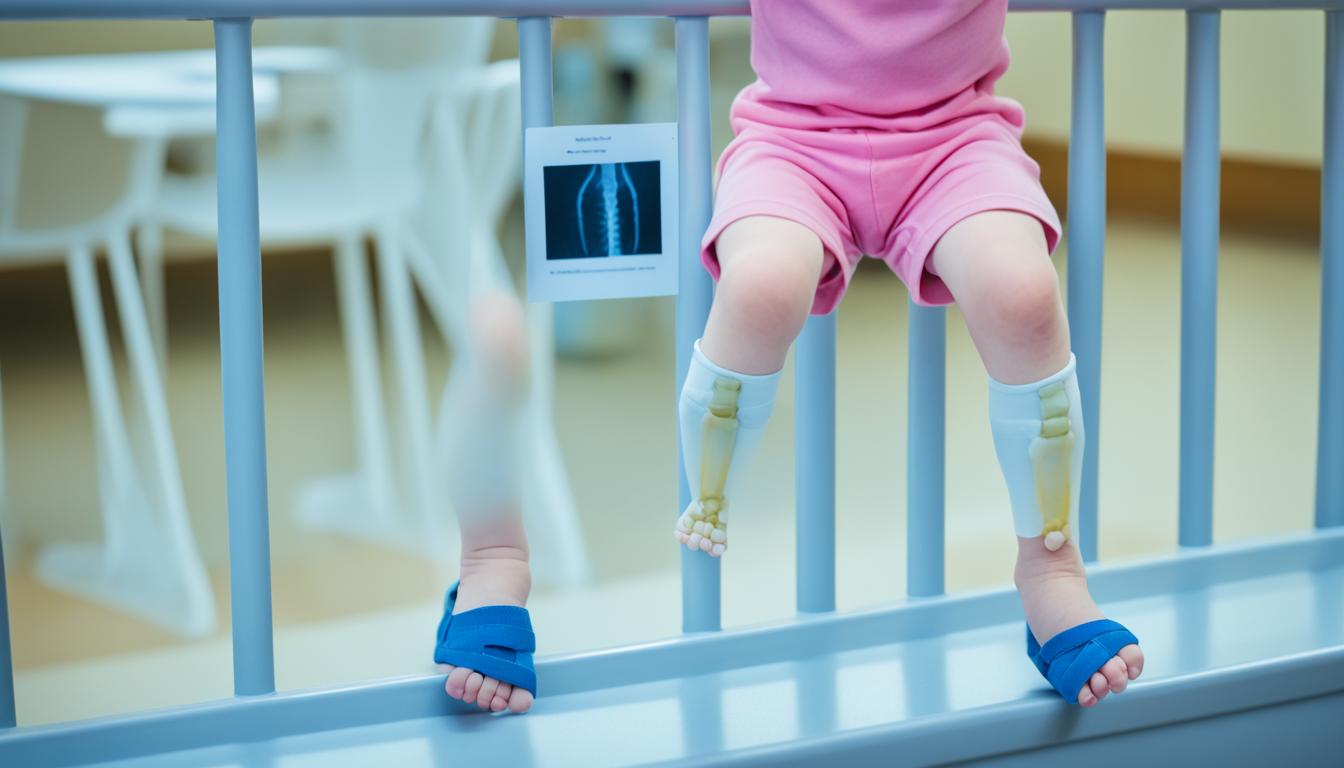Rickets is a disease mostly affecting children. It happens when the body lacks vitamin D, calcium, or phosphate. This can cause bone deformities. Children with rickets might grow slowly and have weak muscles. They’re also more likely to break bones. Sometimes, they feel pain and find it hard to move in their spine, pelvis, or legs.
The disease can lead to obvious changes in how bones look. This includes things like a jutting breastbone or thickened ankles. Kids with rickets might also have legs that bend inward or outward. It is very important to find and treat rickets early to avoid serious problems later on.
Key Takeaways:
- Rickets is a childhood disease that causes bone deformities
- Deficiency in vitamin D, calcium, or phosphate leads to rickets
- Rickets can result in delayed growth, weak muscles, and increased fracture risk
- Symptoms include pain, stiffness, and delayed motor skills development
- Early diagnosis and treatment are crucial to prevent complications
Causes and Diagnosis of Rickets Disease
Rickets mainly impacts babies and kids. It makes their bones weak and deformed. Knowing the reasons for and finding rickets is key to stopping and curing it.
Causes of Rickets
Many things can lead to rickets. A big reason is not getting enough vitamin D, calcium, or phosphate. These are vital for strong, growing bones. Not getting much sunlight can also cause rickets since sunlight helps the body make vitamin D.
Babies who only get breastfed might not get all the vitamin D they need. This is because breast milk doesn’t have a lot of vitamin D. Kids in places with little sun or with dark skin are more at risk of lacking vitamin D. Choosing to be a vegetarian can make rickets more likely too.
Diagnosis of Rickets
Finding rickets includes checking the patient’s history, doing a physical, and running tests. Doctors look for signs like bone deformities, slow growth, and weak muscles.
Tests, like blood checks, look at vitamin D, calcium, and phosphate levels. If these are low, it might show a rickets problem. X-rays help find bone issues, like bowed legs, often seen with rickets.
Spotting rickets early is crucial to prevent issues later on. If you think your child might have rickets, see a doctor right away. They can review and handle the situation properly.
Knowing about rickets helps stop and treat it. The next part looks at how stem cell therapy can help treat rickets.
Role of Stem Cell Therapy in the Treatment of Rickets Disease
Stem cell therapy might help those with spinal issues from rickets. It’s still being developed but looks positive. Adding vitamin therapy in childhood could prevent bone damage.
Stem cells are special because they can turn into different types of cells. They show a big chance to fix the bones of those with rickets. So, stem cell therapy could really change rickets treatment.
More study is needed before stem cell therapy can treat rickets widely. But its promise is clear, giving hope to many. It could lead to better ways to deal with rickets in the future.
FAQ
Q: What is rickets?
A: Rickets is a disease that affects children, causing their bones to deform. It happens when there’s not enough vitamin D, calcium, or phosphate in the body.
Q: What are the symptoms of rickets?
A: Children with rickets may feel pain and stiffness in their spine, pelvis, and legs. They could also have trouble moving properly and have weak muscles.
Q: What are the causes of rickets?
A: Rickets occurs with a lack of sunlight or if kids don’t eat well during important growth years. This lack can lead to not having enough vitamin D, calcium, or phosphate.
Q: Who is at a higher risk of developing rickets?
A: Babies who are only breastfed, kids from places with little sun, or those with dark skin are at risk. A vegetarian diet can also be a factor.
Q: How is rickets diagnosed?
A: Diagnosis involves checking for symptoms, asking about the child’s health, and running blood tests. Doctors might also do X-rays to look for bone problems.
Q: What is the role of stem cell therapy in the treatment of rickets?
A: Stem cell therapy might help treat the spinal problems of rickets. It could be part of early treatment, along with vitamin therapy, to stop bone damage.

